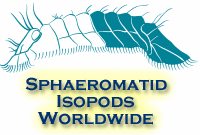| Abstract |
Phreatoicus typicus Chilton, 1 883 was the first described species of the isopod family Phreatoicidae. The species is here redescribed using three female specimens from the syntype series, of which one is designated as lectotype. Until this paper, males of this species had not been described and the biology of the species was poorly understood. New specimens of both sexes from Canterbury Plains (South Island, New Zealand), collected as a part of a year-long environmental survey of groundwater wells near sewage oxidation ponds, are used to supplement the species redescription. The survey also collected data on the biology of phreatoicids and environmental correlates to their presence. Males of P. typicus showed only limited sexual dimorphism, and were similar to those of a related species, P. orarii Nicholls, 1944. Phreatoicus typicus is easily separated from P. orarii and Neophreatoicus assimilis (Chilton, 1894) using characters apparent in the mandible, maxillula and pleotelson tip. Among four wells that were subjected to detailed biological and physicochemical analyses, P. typicus was found at only two sites. These two wells shared substantially higher concentrations of coliform bacteria and lower fine sediment loads than the wells that lacked P. typicus. Thus, unsedimented but polluted groundwaters may be providing a suitable habitat for these isopods. Although our size frequency data for P. typicus were biased toward larger sizes, sufficient numbers of adults were taken to make some general observations on life history. Well-defined cohorts changed in size during the sampling period. Males and females achieved approximately the same maximum length (near 20 mm) and were mature above lengths of 11.5 min. The iteroparous life cycle may span more than one year, and synchronous reproduction was signaled by a large recruitment to the adult sizes during the winter months. |

















